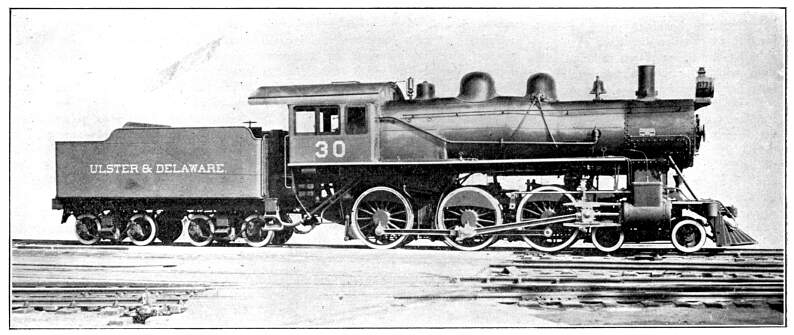Railway and Locomotive Engineering—July,
1907
Ulster & Delaware Ten-Wheeler.
Our illustration shows an ordinary ten-wheel engine (4-6-0)
for the Ulster & Delaware Railroad, built at the Schenectady
shops of the American Locomotive Company. This engine is simple,
with 20 x 26 ins. cylinders, and balanced slide valves, actuated
by shifting link motion. The tractive effort of this engine is
28,100 lbs., and the factor of adhesion is 4.4. The driving wheels
are 63 ins. in diameter, and all are flanged. The guides are arranged
for an alligator cross-head, and the top guide bar is recessed
on the edges so that the side of cross-head and bar are flush.
The butt end of the main rod is forked, and all the rods are of
I-section.

The weight of the engine itself is 164,000 lbs., and the adhesive
weight amounts to 125,000 lbs. With the tender the weight of the
whole machine is 271,600 lbs. The wheel-base of engine and tender
together is 52 ft. ½ in. The engine wheel-base is 24 ft.
9 ins., with a driving wheel base of 14 ft.
The, extension wagon-top boiler of this engine measures 62¼
ins. outside diameter at the smoke box end, and the fire-box is
of the wide type, inasmuch as it extends out over the frames.
The fire box side sheets are straight and the crown and side sheets
are made of one plate, and the roof sheet and the side casing
sheets are one. It is 96-and-three-eighths ins. long by 65¼
ins. wide, and has a grate area of 43.5 sq. ft. The taper sheet
is the second course and slopes up about 8 ins. The heating surface
is in all 2,412 sq. ft., being made up of 143.9 in the fire-box
and 2,268.1 in the tubes, which latter are 304 in number and 14
ft. 4 ins. long. The ratio of grate area to heating surface is
as 1 to 55.4. There is a slight slope toward the rear end of both
crowd and roof sheets, with a 22¾ ins. steam and water
space between them. The back head slopes forward about 12 ins.
There are six washout plugs along the level of the crown sheet,
placed in the fire-box casing sheets, and three in the back head.
The tender frame is made of 10-in. channels and plates, and
the trucks are of the arch-bar type, with 33-in. Boise wheels.
The tank has a water bottom and holds 5,000 U. S. gallons of water
and 9 tons of coal. The cab is roomy and made with three windows
on a side, and altogether the engine is a neat and serviceable
looking machine. Some of the principal dimensions are as follows:
Driving journals—All 9 ins. x 11 ins.
Engine Truck journals—Diameter, 6 ins.; length, 10 ins.
Tender Truck journals—Diameter, 5 ins.; length, 9 ins.
Boiler—Type, extension wagon-top; working pressure, 200 lbs.;
fuel, bituminous coal.
Fire Box—Thickness of crown, three-eighths ins.; tube, ins.;
sides, three-eighths ins.; back, five-sixteenths ins.
Fire Box Water Space—Front, 5 ins.; sides, 3½ ins.;
back, 3½ ins.
Air Pump—9½ ins. L. H.; one reservoir, 24½
ins. x 136 ins.
Engine Truck—Four-wheel, with cast steel swing frame and
swing center bearing.
Piston Rod—Diameter, 3½ ins.
Smokestack—Diameter, 16 ins.
Valves—Type American balanced; travel, 5½ ins.; steam
lap, seven-eighths ins.; ex, lap, line and line inside.
Setting—Line and line full gear ¼ ins. lead at ¼
stroke cutoff.
Wheels—Engine truck, diameter, 30 ins.; kind, Boies.
Driving Boxes—Gun iron.
Ulster & Delaware | Stories
Page | Contents Page







